
PART 1
SINCE 2009 CAPE TOWN'S CHACMA BABOONS ARE
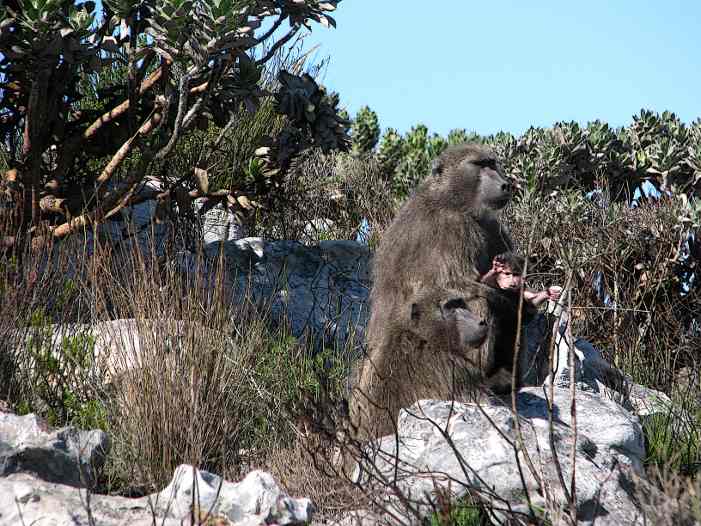
Female
baboons and baby sit together in open space. Increasing
urbanisation has led to loss of habitat, bringing baboons into closer
contact with man, often with fatal results for the animals. Yet
many residents have harmoniously co-existed with the animals for numerous years by securing
properties and bins.
Tourists
can also prevent food-related incidents by closing windows and locking doors
of stopped vehicles (not merely shutting them as some baboons are able to open them with their hands.)
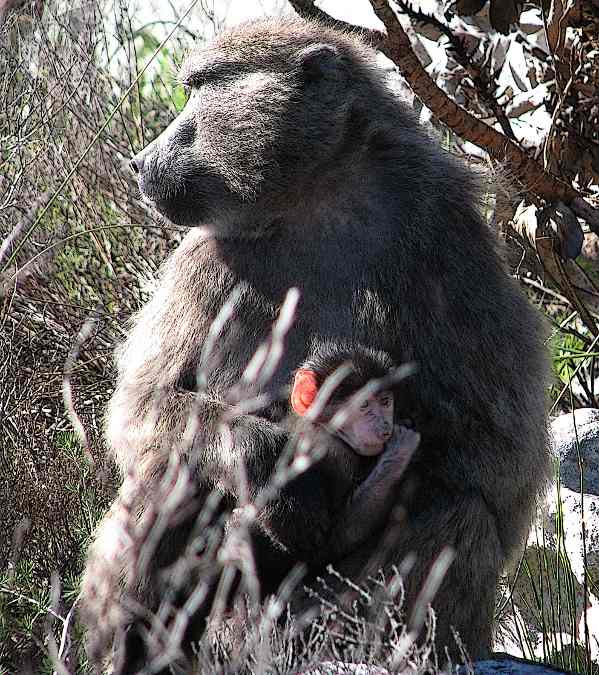
Female baboon holds young baby as they sit in the hills. Baboon monitors were effectively employed by Baboon Matters over the past decade to herd the animals away from residential areas in order to reduce conflict between humans and animals.
Jenni Trethowan of Baboon Matters began her involvement after a local Kommetjie troop of 18 baboons was shot in 1990 by Cape Nature Conservation (now CapeNature). She has received international recognition for her work.
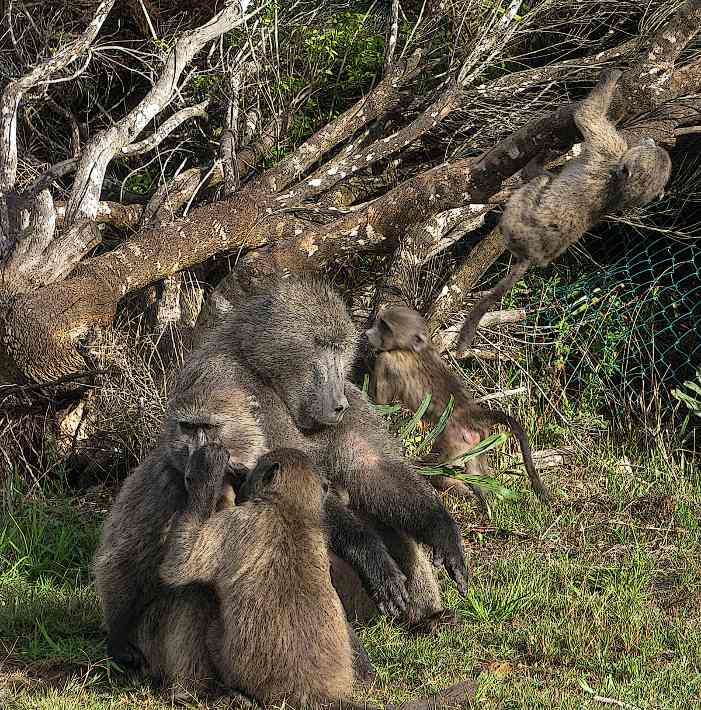
The young female seen grooming her mother's face, was found shot in a resident's garden a month later. As in previous years, a number of baboons were hurt or injured by residents during 2009.
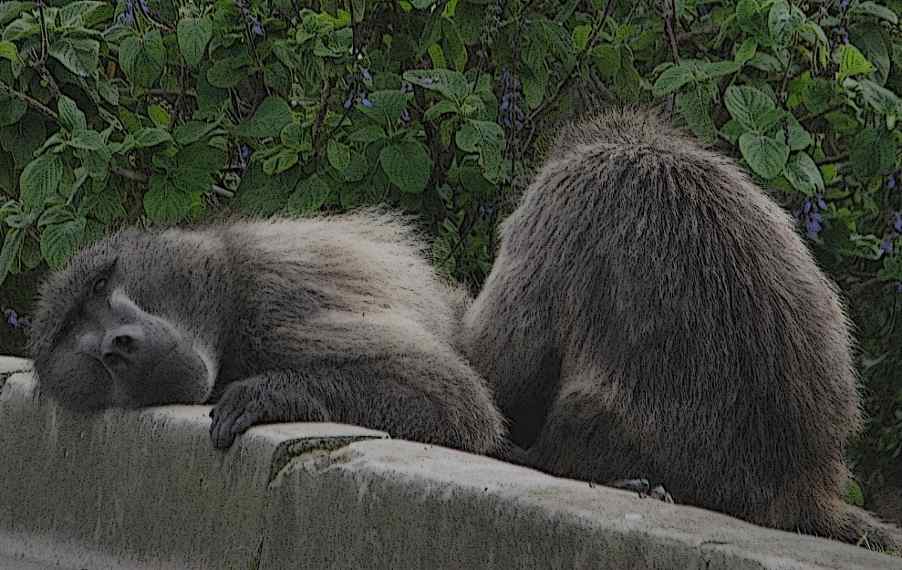

Young baboon samples some fynbos. Predominantly vegetarian, baboons' natural diet consists of flowers, leaves, roots, bulbs, insects, scorpions etc. Those on the coast eat also shellfish.

Female
baboon with baby sits on a rock. Her leg was amputated after she
was shot, shattering the femur. She has had several babies, one ridden over by a car. There have been other amputees
within the troop, as a result of residents' traps and bullets and pellets, testimony of the cruel actions taken against baboons, vulnerable and trusting of humans as they pass through the neighbourhood.
A lack of law enforcement to back up the legal protection of the baboons has been seen to have exacerbated the problem of residents hurting the baboons over the years and some have expressed the opinion that if the stiff penalties in place had been exacted, it would have helped deter people from hurting the baboons. Currently a situation exists where those who want baboons gone from the urban areas, not only harrass the monitors but also those who tolerate Chacma baboons passing through these areas.
Certain lobbies have long called for the removal of baboons from urban areas, themselves at times moving in from other areas. Attempts were made by some during 2009 to portray baboons as a potential threat to human safety to motivate authorities to take action against them.
Not long after, under changed management, an action plan was adopted whereby dispersing males and/or repeat raiders can be culled.
Now again some are seeking to portray portray baboons as a threat to tourists during the World Cup. With a protocol for culling in place, they are even more threatened.
The contract was awarded in July 2009 and again in January 2010 to NatConCor whose manager, Dean Ferreira, was previously employed as nature conservation manager by the City under a previous administration in 2002. At that time he was quoted as saying: "As a conservationist I will not be involved in killing baboons. If we compromise on baboons, then where do we stop?"
Where indeed?

Adult
male baboon in a pine tree which provides sleeping place and food from
nutritious pine nuts.
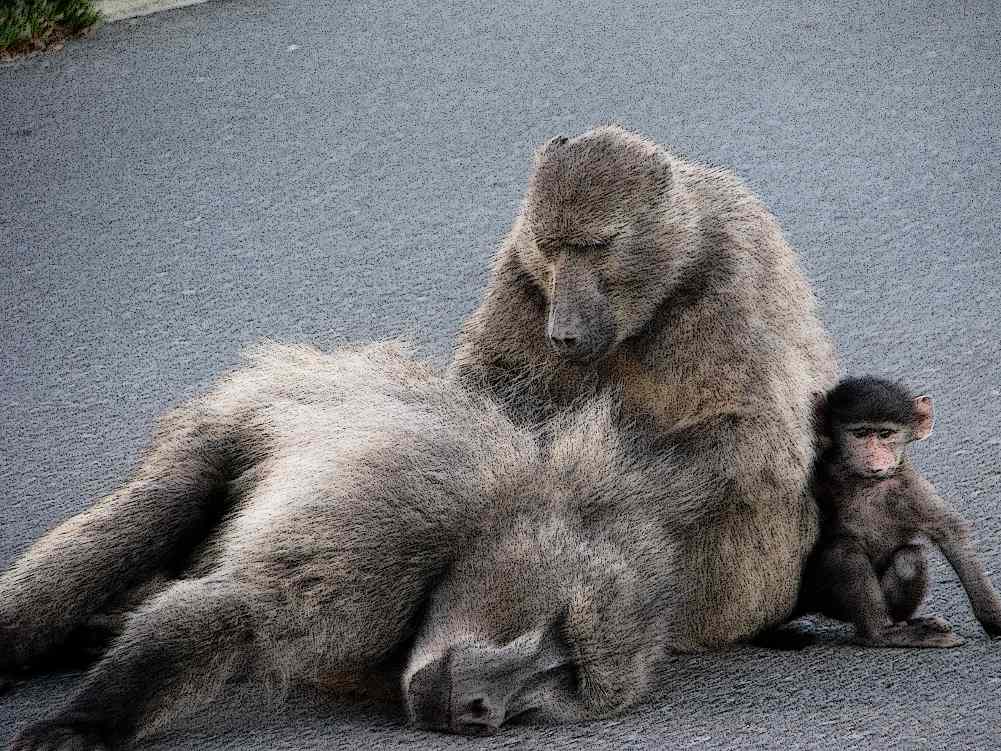
Alpha male enjoys the warmth of the tarred street as he is groomed by female, while baby looks on. Male baboons are excellent fathers, and are very protective of their young. The "dispersing male" category protocol specifically targets male baboons. According to the protocol, they can be killed if leaving their natal troop and coming into the urban area any time from the 2nd to 4th capture after initial tagging.
Sometimes males leave the troop temporarily if fighting for dominance occurs in order to escape further injuries, yet the culling protocol can be initiated if they come into urban areas. This is not difficult as the Peninsula layout borders or cuts into their home ranges, in some areas separated by only a street.
In terms of the protocol the legally protected Cape Chacma baboons are now essentially being defined as "damage-causing animals", problem animals i.e. vermin - the same status as in other parts of the country where they are killed with impunity. As such the protocols attempt to override their protected status.


Young baboon plays with a bottle. Residents' failure to secure homes and bins and tourists feeding baboons has resulted in unnecessary suffering for man and baboon. By consistently taking correct security measures, residents can live for numerous years without any baboon incursions and enjoy the occasional sighting of this intelligent and entertaining wildlife. Feeding of baboons by tourists teaches them that food is available from humans and they may even try and grab it from them.
In areas like Cape Point there have been warning signs for decades not to feed baboons, yet some tourists continue to do so and if caught can be fined.
Tourists are warned to lock car doors rather than merely closing them as baboons can open them, avoid displaying food in areas baboons frequent and not feed them or make food available. (Food should also not be carried in packets or backpacks when baboons are around as they can smell it and may try to get it.)
People should not
confront or seek to take back food or belongings from baboons as they can become possessive and fight to retain them. If inedible, baboons will lose interest and drop the item.
Given the baboon males' protective role, tourists should also avoid getting too close or attempting to touch the young. Avoid direct eye contact with baboons, seen in primates as threatening or aggressive behaviour.
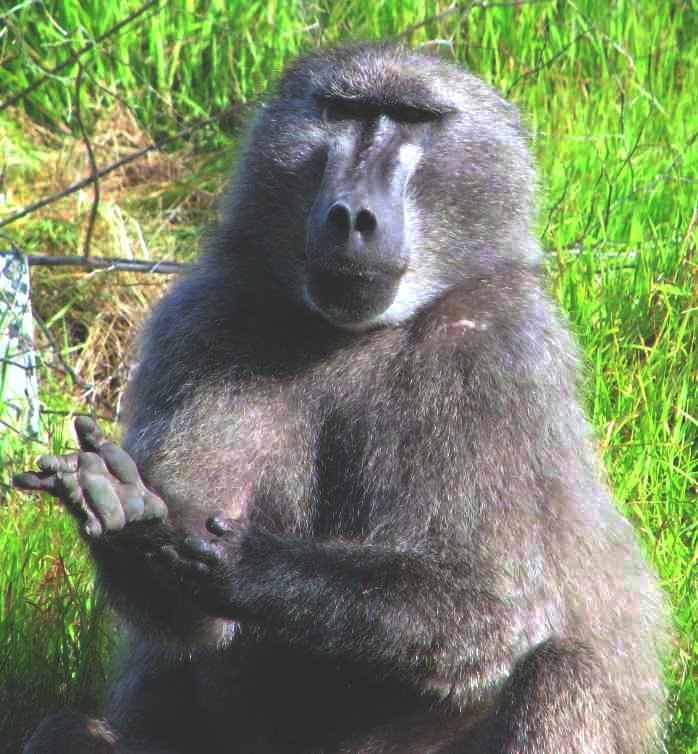
Adult male baboon recovers after
being shot with a .22 pistol in a residential area. Vets found he had
a fractured femur and multiple projectiles in his body, as have
other baboons. The same baboons are often attacked on a number of occasions with Baboon Matters receiving numerous calls each year
regarding injured baboons.
Although ostensibly protected by law
with stiff penalties, virtually no prosecutions have been effected
in the past and a lack of law enforcement has been seen as encouraging residents
to act against baboons. Now baboons are threatened
by a new protocol which not only allows them to be culled but in effect attempts to strip them of their legally protected status including on the grounds of being "repeat raiders".
While during 2009 there was some focus on law enforcement for tourists feeding baboons, residents continue to hurt baboons and not take proper measures to secure bins and houses.
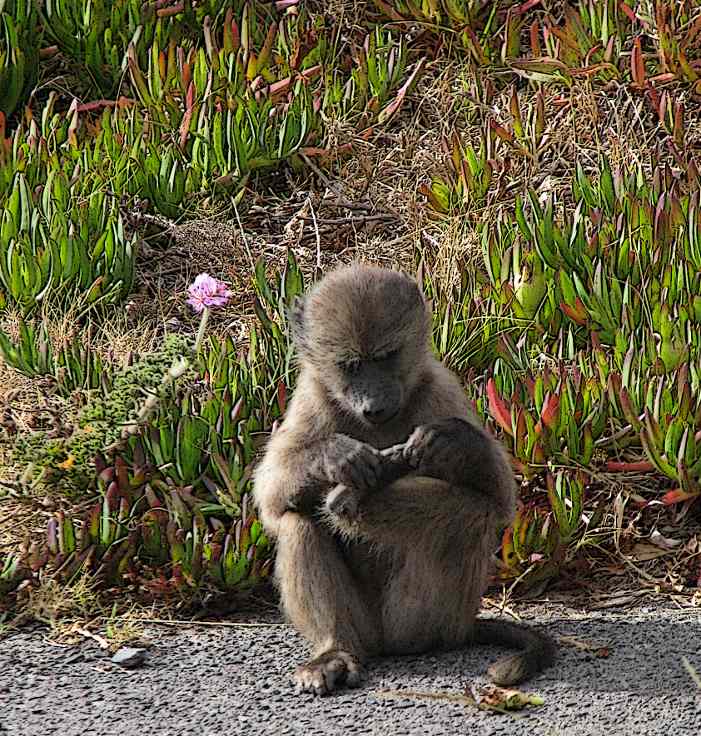
Small baboon examines its foot. While still young, it is able to ride on an adult's back if weary.
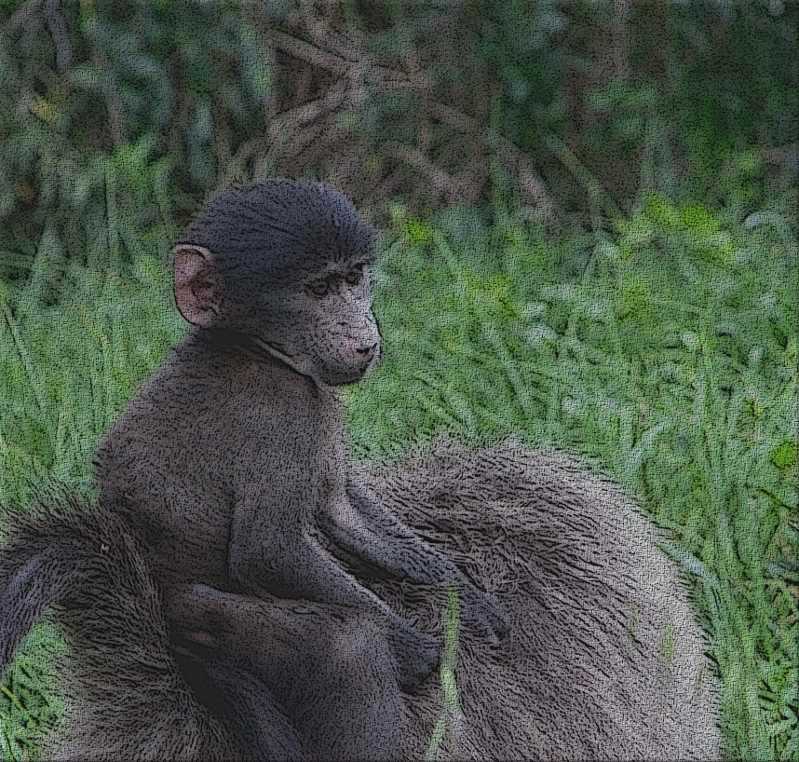
The bond between the mother and her youngster is strong. Females carry their dead youngsters around for days, mourning their loss. Connections between troop members are also strong and removal of males under the new protocol could have adverse effects on troop dynamics and structure.
The
Chacma baboon troop is hierarchically structured with an Alpha male
being the dominant leader. Male
baboons play an protective role in troop structure, important in
free-ranging baboons and maintain order in the troop, sorting
out squabbles.
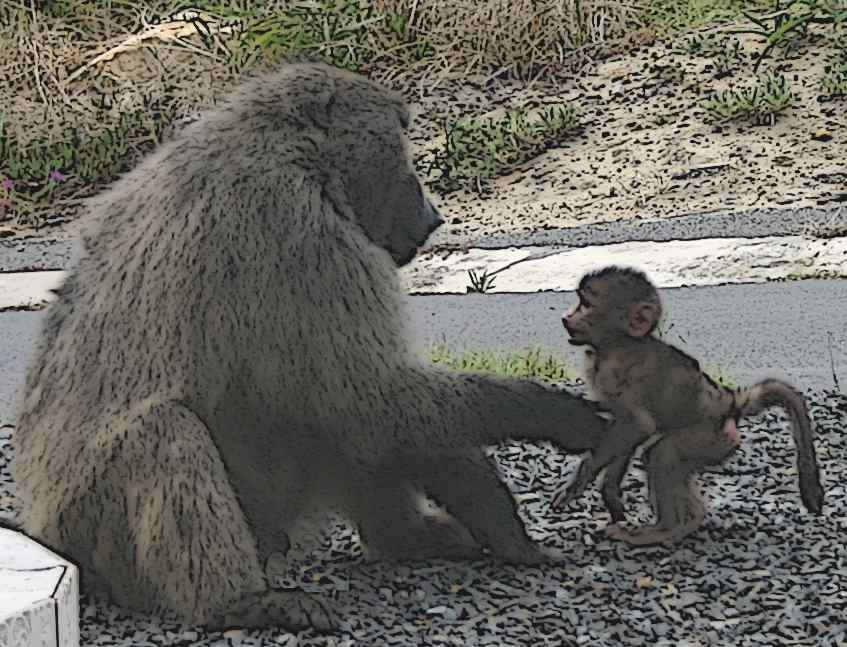
Alpha male (George) gently touches baby baboon. Males communicate with reassuring grunts as a baby approaches. The role of males within the troop is to protect the young and they are excellent fathers. Their reaction when a baby squeals is instantaneous, ready to come to its defense,
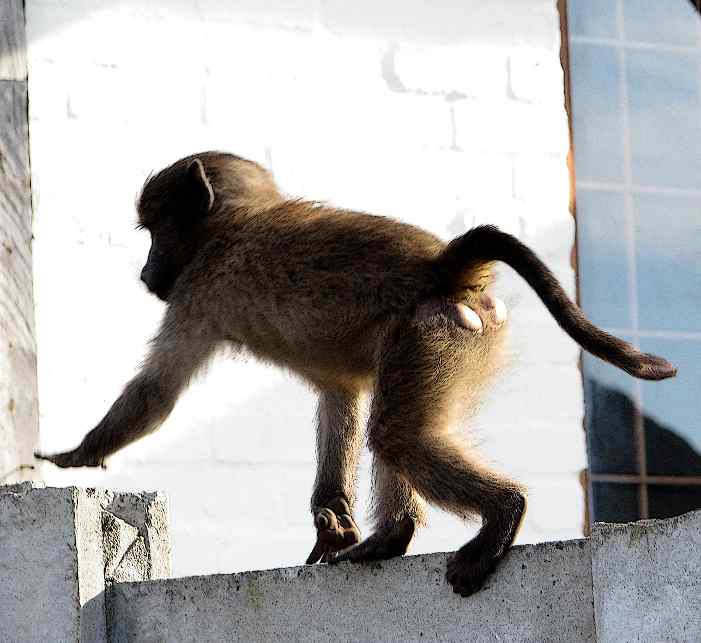
Young baboon walks along a vibracrete fence. While the window seen here is barred, the gaps are too large, allowing not only a small baboon in, but even a grown baboon. As long as the head can fit, baboons are able to squeeze through a small gap. (Less than 8 cm is the recommended size.)
Although
some people will never tolerate baboons for their own personal reasons,
including fear or ignorance or a belief that man must "exert dominance"
over animals, or that they see no place for wildlife in human
habitation, much of the conflict between humans and baboons, is a result
of
people taking inadequate or no security measures to prevent access to
homes or garbage bins.
Those residents who do take proper precautions experience little or no trouble from baboons over many years. The new protocol ignores the role of human responsibility and places the blame on natural predictable baboon behaviour, just as some residents do.
Some residents do not understand baboons' reactions and behaviour and this ignorance and fear can lead to hatred.
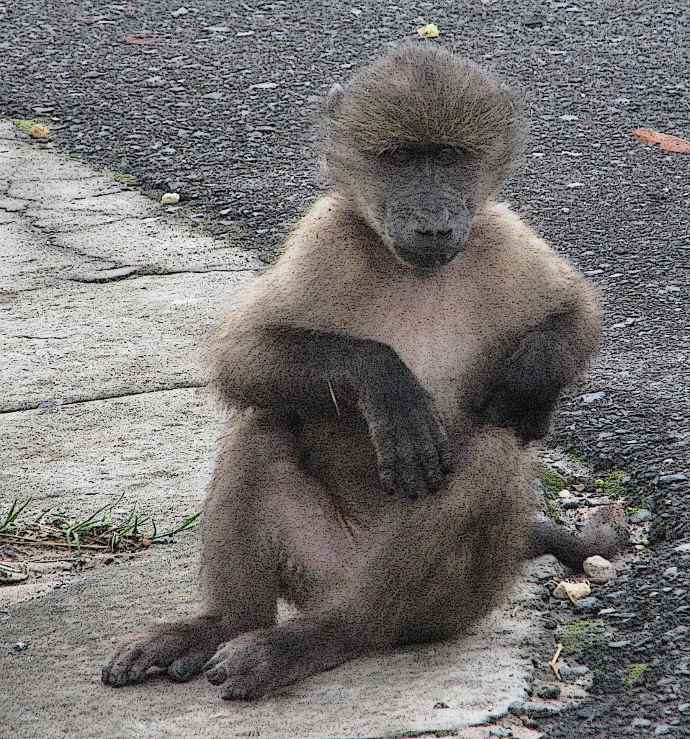
The Chacma baboons, considered to
be a large baboon, are essentially the weight of dogs and puppies. Adult male baboons weigh 30-40 kg, females half that,
youngsters and babies are much smaller.
Baboons
are not predators of man, are not considered "highly dangerous"
to man. However, they are wild animals,
should be treated with respect and not cornered or threatened or teased. Male baboons do have long canines given for defense against their natural predator, the leopard.
Although baboons show remarkable restraint in dealing with humans, it is wise not to put yourself in a situation that could possibly result in a bite or scratch should they feel cornered or threatened.
Never attempt to grab food or possessions back as baboons will try to retain it. If not edible, the baboon will lose interest in the item. Although people consider the young to be "cute", they should not be touched or threatened, given the males' protective role.

Alpha male (Peter) sits with his youngsters in a tree.
Photo of Bart courtesy Baboon Matters
All Content Copyright 2009-2010
All Rights reserved L Thomas
No portion of content may be reproduced in any way without written permission
Before the Cape Peninsula was colonized, baboons traversed the slopes of Table Mountain. Today, both are popular tourist attractions. Many visitors, as well as locals, enjoy watching the entertaining free-ranging baboons, so much a part of Cape Town and its history.
For the last decade the Peninsula baboons' numbers have remained at little over 350 in around a dozen troops. The lack of increase in numbers is in part attributable to baboons being injured and killed by some residents. Though legally protected during this time, there has been little law enforcement in the past to prevent or discourage this illegal behaviour.
Since August 2009, the Peninsula's baboons have come under additional threat due to new management strategies including a controversial culling protocol. It has been criticized by independent scientists, primatologists and experts as flawed and biased against baboons' natural behaviour, ignoring human responsibility in baboon-proofing.
Many people are amused by the antics of the intelligent Chacma baboons, but life is often no fun for the remaining baboons of the Cape Peninsula.
After a 3 year poverty relief grant that paid for monitors' salaries expired in September 2008, the City was the sole supplier of funding.
(Legal opinion was expressed that all 3 major stakeholders contribute financially. While the grant had been facilitated by the conservation authority CapeNature, they together with the other major stakeholder SANParks, did not see financial contributions as part of their mandate. SANParks saw its own management of baboons as applying only to those within the Table Mountain National Park area which includes Cape Point Reserve.)
As a result, in the first months of 2009 some troops had no monitors due to lack of funding. Baboons consequently were more frequent visitors to those areas, including Simonstown. Some residents agreed to put pressure on the authorities to take action. A number of residents in these areas were long opposed to any baboon presence whatsoever in the urban area.
In July 2009, shortly following a baboon summit, the so-called "baboon expert workshop" hosted by the City in partnership with CapeNature, the interim monitoring contract was awarded to another service provider away from Baboon Matters, the organization successfully managing the monitoring system during the last years.
(When a troop of 18 baboons was shot in 1990 by Cape Nature Conservation (now CapeNature) it caused a public outcry, also serving as a catalyst for Jenni Trethowan, manager of Baboon Matters to begin her involvement with the baboons.)
The awarding of the contract by only a select group of the Baboon Management Team (at the time chaired by CapeNature representative, Natasha Wilson who resigned from CapeNature at the end of 2009) drew allegations of a flawed process, prompting the CEO of the local Cape of Good Hope SPCA, Allan Perrins, to refer the matter to the Public Protector.
In August 2009, just weeks after the new interim service provider took over management, a controversial "Action plan for Dispersing males and repeat raiders in the Cape Peninsula" was introduced.
While the protocol has initially targeted male baboons coming into the urban area, it could potentially be used to subject any baboon to culling as opportunistic feeding baboons will "raid" i.e. eat unsecured human food.
Additionally, of further concern is that the protocol appears to override their legally protected status by defining them as repeat raiders i.e. damage causing animals or vermin, the status they have in the rest of the country where they are killed with impunity.
Baboons are opportunistic feeders that share a taste for human food, including favourites of bread, pasta and fruit. They have sharp eyesight and a keen sense of smell and are intelligent and dextrous. If residents do not secure bins and houses and if tourists do not lock cars, baboons can and do raid residents' unsecured bins and properties, just as they can and do raid tourists' unlocked cars.
The protocol is heavily biased against baboons for their predictable and/or natural behaviour while ignoring human responsibility. If people are "repeat non-securers" baboons will naturally be "repeat raiders".
In 2009 a number of young healthy males were placed on "death row" when captured and ear-tagged on the basis of being "dispersing males" when leaving the troop. The protocol allowed for 4 captures - the first ear-tagging was followed by options, several of which are either unfeasible or are not currently utilised such as sterilisation and castration. Culling, however, is the constant option from the 2nd to 4th capture.
Some felt the protocol was also unfairly biased against male baboons, giving authorities the leeway to potentially and specifically kill males, who could then be labelled as "problem animals" for whatever reason, including claims by irate residents who opposed baboons ever coming into residential areas or used spurious allegations of potential threats to human safety.
Baboons are not perceived by experts as being highly dangerous to humans as they are not predators. Conflict over food is avoided by not making it available and by not attempting to grab items back which baboons will hold on to, and by not confronting or threatening them.
Being predominantly vegetarian, female and younger baboons do not have the long canines of mature males given to facilitate the males' highly protective role particularly in protecting the troop against baboons' main predator in nature, the leopard.
They are also used in fights for establishing dominance. Males naturally fight for dominance and ranking in the hierarchical troop structure which gives greater access to females and food.
During these sometimes fierce fights, they may leave the troop temporarily, so avoiding further injuries. (In some areas, the urban area immediately adjoins their home range making it entirely possible that they will pass through an area.)
Males may eventually also leave and start their own "fission" or split troop within the same general area or attempt to join another troop further away. If dispersing to another troop, it is often a gradual process. Dispersal is also documented as occurring at various times throughout a male's life.
The protocol claims it gives the baboon an opportunity on the third capture of being taken to a new troop, yet there is often little chance of them being accepted, particularly if it is a troop with one or two males who will fight fiercely to defend the troop against an intruder. If having left his natal troop due to fighting for dominance, when taken to a new troop he will encounter further fierce fighting if attempts are made to join the new troop. The dispersal process has been unnaturally expedited by the protocol. Culling is the outcome if this 3rd capture and release to another troop fails.
(Attempts since the introduction of the protocol have not proved successful with males such as Bart, Sol and Anele not having been integrated into the troops they were taken to. Sol was culled in terms of the protocol. Anele, son of Eric the oldest Peninsula baboon" who once both embarked on a father-son walk to visit several coastal towns, was being chased during a fight by another male of the troop he had been taken to, but which he had not been accepted into. He ran across the road during such a fight near a baboon sleep site and was hit by a car.)
While a dispersing male and/or repeat raider may be given "a chance" of being integrated into another troop on the 3rd capture, culling is already an option from the 2nd to 4th and final capture making the real focus of the protocol culling should baboons come into the urban area.
The process of culling starting with eartagging can be initiated if baboons come into the urban space - often difficult to avoid, given the Peninsula layout and the fact that urban areas cut into their home ranges. In some areas the difference between what is considered to be the baboon home range and the urban area, is a short walk across a street. This again shows the bias of the protocol against baboons and the circumstances they find themselves in.
There are fewer adult males than females in the troop but males fulfil a key role of leadership and protection of the young and females and maintenance of order in the troop. In some troops on the Peninsula the number of males is already greatly skewed in favour of females. It is not only the Alpha that is important for protection and care of the young and females but other males also play a role in Chacma troops.
Whereas the natural ratio of male to female is given as 1 male to 2 or 3 females, in a number of Peninsula troops there are many more females than males.
The rationale behind introducing the dispersing male to a new troop with a so-called "vacancy for a male" does not hold, as the Alpha males of such troops can and do fight fiercely to defend the troop against an "intruder", as occurred in the case of Anele. Several months after been brought to the area he had still not been allowed by the Alpha male to join the troop with females and babies.
Removing males can also cause disruption in the troop dynamics and lead to increased tensions and fighting as the hierarchical structure is in flux as other males battle for ranking. It may also lead to deaths of other troop members, including youngsters and infants. If a male succeeds in becoming the new alpha, this may result in infanticide, which brings lactating females into the reproductive cycle again, so perpetuating the new male's genetic line.
Bart was one of the first baboons to be targeted in terms of the protocol and after the protocol's introduction, acquired a "folk hero" status as he managed to avoid the dart even while still frequenting UCT campus, the home of the Research Unit closely involved in the preparation of and endorsement of the protocol or "Action plan for dispersing males and repeat raiders". Bart was popular among the students there.
The unit has made other recommendations criticized by independent scientists and experts as either scientifically flawed or not in the baboons' best interests eg the use of bull whips in monitoring.
While the unit claims a digitised map of baboon home ranges presented to the City and Department of Environmental Planning is "the single most important step in the conservation and management of baboons on the Cape Peninsula", the protocol itself could be regarded as the single most important step in threatening and reducing the numbers of the baboons of the Cape Peninsula.
In essence objections to the protocol are that it could be used to target any adult male leaving the troop and coming into the urban space, raiding or causing damage. Through the category of repeat raider it could potentially target any baboon of any age. At the same time it attempts to override their legally protected status in declaring them as damage causing animals.
In October 2009 a cage trap was set for a male, a troop leader, whom a shop-owner claimed repeatedly raided his premises, simply strolling in through the unsecured door and taking available food near the entrance. The shop is within the baboon home range and they pass by to various sleep sites in the area and baboons will predictably attempt to obtain the available food. Baboon-proofing is cited as "inconvenience". Some residents also blame baboons for raiding but take no precautions to prevent them doing so.
If personal responsibility in securing properties is not addressed and the baboons continue to raid, the terms of the protocol are hardly unbiased if human responsibility is ignored, putting baboons at risk of culling.
The need to baboon-proof an area applies also to the Cape Point Reserve area, scene of many food grabs in the past by the troops there. One reason has been food has been permitted by officials to be sold or carried or accessed in sight of the baboons. Just as baboon-proofing must apply to individuals, businesses it must also have application here.
By using the "repeat raider" category, most of the Peninsula's baboons could be potential candidates for culling even though residents repeatedly fail to secure property and tourists make food available by feeding them or failing to close car windows and lock doors.
Given the males' protective role, tourists should also avoid getting too close or attempting to touch the young, even though seen as "cute". They should avoid eye contact with baboons, seen in primates as threatening or aggressive behaviour.
The protocol seeks to do away with the Cape Peninsula baboons' protected status, something many residents still find hard to accept could happen.
The legality of the protocol must be questioned, given that it contravenes the existing laws protecting baboons. There have been calls made to the City to revoke the protocol.
The City of Cape Town was the only supplier of funding including for an interim 6 month contract until the end of January 2010. A City tender closed 21 December 2009 for a new interim baboon management contract from 1 February - 30 June (extendable for another 12 months although the possibility of a long term 3 year contract has been mentioned).
The tender called for quotes for the "removal, relocation and/or euthanasia" of a certain quantity of dispersing males per month, further adding to concerns about the baboons' future.
The contract was subsequently again awarded to Nature Conservation Corporation. In 2002, the M.D. of the company, Dean Ferreira, formerly employed to manage some of the City's nature reserves had been quoted in the press as saying that as a conservationist he would not be involved in killing baboons.
Many believe that there has not been sufficient public participation from those who are concerned about the welfare of the short and long-term welfare of the baboons, in decisions being taken about Cape Town's free-ranging Chacma baboons, particularly since there could be such potentially negative consequences on an already endangered population of little more than 350 baboons in around a dozen troops.
Given what has appeared to be an increase in word and deed against the ostensibly protected baboons over the past months, including allegations of baboons being "increasingly aggressive" by some residents in an apparent attempt to motivate authorities to take action against them, as occurred earlier in the year prior to the "baboon expert workshop", great concern has been expressed about the future of the baboons both in the short and long term.
Below are some of the remaining baboons of the Cape Peninsula, now seemingly under greater threat than ever due to controversial management strategies such as the August 2009 culling protocol.
2009